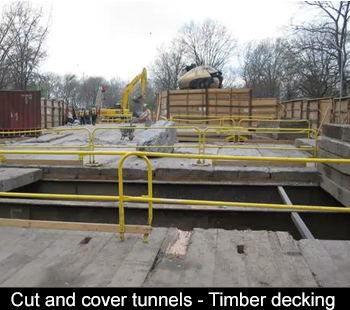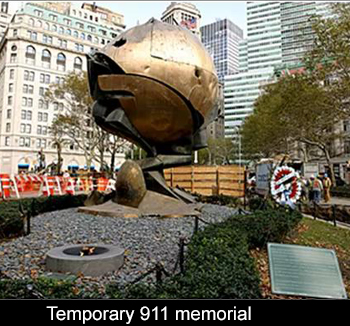Welcome to class number 6, a continuation of the subject of cut and cover tunnels. We are visiting a new site, a different site from class number 5, and this is also a cut and cover tunnel. The conditions here are quite different and some of the means and methods are different.
 In this area, which is decked over and you can see the horizontal deck beams, but this is covered over with timber mats instead of concrete panels. At the start of my career, this was the common practice to use timber mats, lashed together to form panels and they would span over the deck beams. These mats are actually spanning over two deck beams, so they are covering about 16 feet at a time.
In this area, which is decked over and you can see the horizontal deck beams, but this is covered over with timber mats instead of concrete panels. At the start of my career, this was the common practice to use timber mats, lashed together to form panels and they would span over the deck beams. These mats are actually spanning over two deck beams, so they are covering about 16 feet at a time.
This is what was normally done, but the traffic would begin to wear the mats and also polish them. On a rainy day, they would be very slippery. The fact that the mats would become worn and uneven is something that we as contractors welcome, because that would slow down the traffic and keep them from zooming through the work site.
But in the rain, they really were slippery and perilous. While slowing down, the traffic might have been a reasonable goal, it certainly was not a good idea for the traveling public. When concrete panels came along, they were quickly adopted as the most suitable method. They give the public the best ride. They're also heavy and stable. They don't wobble around and jump around. They make much less noise.
From every point of view, the concrete panels are a much better solution. Why do we still see timber panels being used here? Well, this is a photo from within the work area. The public is excluded from this area. So there is just a modest amount of construction traffic taking place. And the timber panels under these conditions are a perfectly good solution.
Note in the background, this historic sculpture and I'm going to walk around the fence and show you what that sculpture is.

I'm standing here in Battery Park at the southernmost tip of Manhattan Island, and we're looking at a sculpture which is being used here as a memorial to the events of 9/11. The sculptors name is Fritz Koenig. This sculpture stood at the World Trade Center site right at Ground Zero and it was re-excavated with the remains of the buildings. Of course, it was severely damaged, but more or less retained its original shape and was valued as a relic from 9/11. There is a perpetual flame burning in front of it and it seems to me a very, very suitable reminder and memorial of those events.
This project being constructed here is a new subway terminal at the tip of Manhattan. It replaced an outdated existing station and it caught the interest of The Discovery Channel. They did a one-hour program which was exciting and fun to watch, but not really an educational program. It has this very rapid editing, which reminds me of a rock music video, but it was fun to watch and I've extracted a short segment of it for you to look at, but because of this rapid pace and the short clips I wanted to first orient you to the activities.
This is a plan of the existing site and, in red, you see the number one line. That's the Seventh Avenue local. It comes all the way down to the tip of Manhattan. This is the last stop on the 7th Avenue local. And in white is the existing station. This is a historic station. It's probably older than 100 years old. It has beautiful ceramic mosaics inside depicting historical scenes of New York City. It's quite a lovely station, but it certainly is outdated.
The station is very short at the new equipment. The new trains are much longer than the station, so that only the front half of the train can enter into the station and people have to move up to the first four cars in order to get off at the station. The cars have gotten longer and longer over the years and because of the tight radius, they cannot get in close to the edge of the platform.
New York City Transit has introduced traffic extenders. I don't know if these are widely used. This could be a local invention to solve this problem.
The extenders at least prevent people from falling through this gap. When the train doors close, the body of the train itself pushes the extenders back in place. It all has a kind of a Rube Goldberg look and is terribly outmoded. So this project replaced the existing station with a brand new station.
In addition to the number one line, shown in red, the number 4 and 5 trains also pass through this site. They're shown here in green. You have the task of passing under each of these facilities. You have to pass under the red line. The excavation passes under the red line, under the green line and under the existing station. Naturally, there was a major underpinning effort required to safely pass under these lines without interrupting service.
The excavation is a mixed face tunnel, meaning that it's partially an earth and partially in rock. This clip from the video shows the rock at the moment that it's being blasted. You cover the rock with protective mats to ensure that no rock escapes. That was done in this project, but from time to time, the mats were really thrown about, which is extremely dangerous. You need a sufficient number of mats to make sure that the mats barely move at the time the explosion is set off.
At the end of the video, they show a concrete slab being poured, but they actually show other clips of other slabs being poured. It's a little hard to follow. They jump around, but I've pulled out this clip in particular, because this is the first concrete that you pour when you complete your excavation.
It is not the structural box. It is an underlining, concrete pour, which is called a mud slab. The purpose of the mud slab is to even out the rock excavation and to create a level, flat work surface on which you will build the structural box. This is called a mud slab.